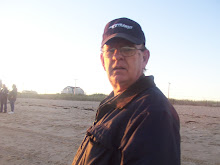
The Pembroke Voice
The latest piece of compelling paranormal evidence captured by a research
team and film crew in England has researchers listening... and talking.
By Jack Roth and William G. Everest
A strange paradox exists in the world of the paranormal, one that has stifled the forward progress of research and can be linked directly to human shortcomings.
Scientists, scholars and researchers — some of the brightest minds of the last century — have gone to great lengths to capture tangible “evidence” to support the existence of paranormal phenomena, yet when truly compelling evidence is presented, the controversy that invariably follows makes clear conclusions difficult to reach.
When the Latvian psychologist Dr. Konstantin Raudive published his eye-opening findings on electronic voice phenomena in the late 1960s, it caused a great controversy in the scientific community. Leading electronics engineers, physicists, and psychologists were invited to carry out controlled experiments to validate Dr. Raudive’s findings, which suggested it was possible to capture voice messages from dead friends and relations. Even the Churches were interested because the answer could affect the whole question of whether consciousness survives bodily death.
In the end, after much debate, Dr. Raudive’s voices still remain inconclusive. Could he have found the “smoking gun” needed to “prove” the existence of a spirit world? Possibly, but we may never know for sure. Just as some of the better photographs and compelling eyewitness testimonies that have surfaced over the years, the voices, instead of promoting a sense of camaraderie amongst researchers, in many cases appear to have created a blurring of the line between objective analysis and a more dismissive skepticism.
Recently, more startling evidence of possible haunting activity was captured in the bowels of Pembroke Castle in Wales. It has been dubbed the Pembroke Voice and is being hailed by some as chillingly significant paranormal evidence.
Some researchers, however, aren’t convinced. One grizzled veteran of paranormal investigations recently noted: “Unfortunately, we live in a media-driven society, with competition for public attention being a paramount consideration. In such an environment, one may feel pressure to provide an appealing product that will satisfy the curiosities of a mass media consumer market. Good entertainment however, shouldn’t be confused with good science. Although entertainment and documentation aren’t necessarily mutually exclusive, the latter shouldn’t be judged ‘genuine’ and rushed before the public eye merely because it was captured on tape. The objective observer should always be aware of the possibility of misinterpretation or misperception.”
The Investigation of Pembroke Castle
Originally a Norman earth-and-wood castle built in 1093, Pembroke Castle was eventually strengthened and went on to become a strategic stronghold during the Middle Ages. It was one of the main ports for traveling to Ireland and the seat of the earls of Pembroke. The castle and its earldom passed between various families and the crown throughout the 14th century, surviving the ravages of time. In 1457, it became the birthplace of the Tudor dynasty’s first monarch, King Henry VII. Pembroke Castle continued to be connected with royalty and national politics through Henry VIII and Anne Boleyn, who became Marchioness of Pembroke. Steeped in history, the castle remains one of the greatest pre-Edwardian castles in Great Britain.
The Pembroke Project was a joint venture between Fifth Twilight Films and Spirit Level Paranormal Investigators (both groups based in England). They set off for Wales on June 23, 2006 to perform a weekend investigation of the ancient ruins at Pembroke. It was the third joint investigation conducted by the two teams in an effort to document footage for a feature-length documentary on the paranormal.
On the second night of the investigation, members of the team decided to enter Wogan Cavern — a natural cave over which the castle was built — at approximately 12:30 a.m. After being in the cavern for only two minutes, they heard the voice of a man screaming, “Let me go. I can’t take it anymore!” Barely audible at first, the voice continued to grow louder and become increasingly distressed until it suddenly stopped 30 seconds later. The voice was recorded with a Sony Mini DV Handycam on DVM60 Mini DV Cassette.
Fifth Twilight Producer Fran King was present when the voice was heard and is convinced it wasn’t a member of their group. “I was aware of where everybody was at the time the voice was recorded,” she says. “I had personally locked us into the castle at the beginning of the evening after making sure all members of the public had left the site. The keys remained in my care for the whole of the night.”
The investigators were caught off guard. King recalls that she was “very shaken when I heard the voice and was unable to listen to the playback for three or four days,” and although other members of the team thought at first that it was a drunk outside, she “knew it was too panic-stricken and coming from the wrong direction for this to be the real answer.”
Alan Smith, lead investigator for the Spirit Level team, also remembers being rattled: “I heard the voice with my own ears, initially believing it to be a drunk outside the castle. We attempted to identify a rational explanation for the phenomenon, without success. Everybody who heard the voice was visibly distressed, but we still had a job to do.”
Nadine Culley of the Spirit Level team gives a similar account: “I heard the voice approaching from a distance. The volume increased to a frightening pitch before stopping dead. Then just silence … and fear.”
“I heard the voice very clearly,” says Tom Mart, another member of the Spirit Level team. “I’ll never forget how that sound made me feel … how it made all of us feel.”
Murray Stewart, member of the Spirit Level team and executive producer of the documentary, was leading a separate vigil in another part of the castle, some 300 yards away, when the voice was heard. He couldn’t see or hear the events unfolding in the cavern from his location, but he distinctly remembers arriving at the cavern and listening to the recording. “My initial reaction was incredulity,” he says. “I’ve never heard anything like it and didn’t know how to process it. I instinctively knew that the recording was genuine due to the emotional state of the witnesses and the strict control of our environment.”
Wogan Cavern is underneath the castle, and the entrance to the cavern opens out onto a public walkway. The immediate reaction of some team members was that it must be a man outside who had had too much to drink. “As team members waited for the drunk to pass, they switched off their torches and covered the camera, not wishing to attract attention of a man who was clearly distressed,” says Jonathan Francis, director with Fifth Twilight Films. “But no man passed the entrance of the cave.”
Sound recordist John Hughes was adamant the sound came from within, as the following morning the team tried to reconstruct the voice to no avail. “There was no way the crescendo of sound could have been so powerful if it was made on the walkway outside the castle,” he says. “The sound came down the spiral stone staircase into the cavern, yet no footfall was heard whether live or on the recording. No one was on the staircase; no one else was in the building.”
Corroborative Evidence
One way to enhance the validity of paranormal phenomena is to collect corroborative evidence. Capturing a voice on tape is one thing, but if you’re also able to capture a full-form apparition on videotape at the same time, document three or four similar psychic impressions of the area in question and research history that suggests a possible connection, scientists and researchers will tend to raise their eyebrows a bit higher.
Sunflower Art, Crafts and Snacks! a dozen ideas
10 years ago






No comments:
Post a Comment